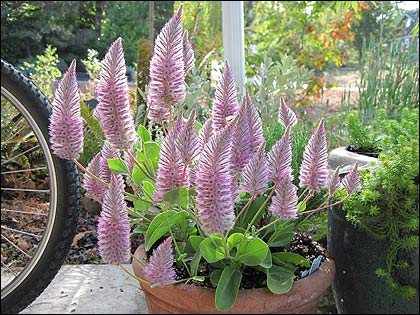
Carefree Color
Container gardening can be low-maintenance
By Rachel Foster
 |
| Ptilotus •Joey |
The cool, wet spring set a lot of gardeners back this year, myself included. Im still stuffing ornamental plants in containers. Plants grow much faster once the weather warms and I know they will soon catch up, so it doesnt bother me that its July already. The only problem is that there is so much else to do in summer.
If tending and harvesting veggies (or, for that matter, hiking, wind surfing and botanizing) keeps you busy all summer you probably dont welcome the extra work of grooming and deadheading high maintenance container plants. Some traditional annuals like geraniums and petunias certainly deliver a big color punch, but they can look a mess if you fall behind on deadheading. There are, however, ways to achieve container plantings that deliver plenty of visual excitement with very little attention. Set up drip-lines to your pots and you can almost forget about the watering, too.
Ive never fully accepted the argument that container plants are water hogs. After all, the water is specifically directed at the roots. Plants in porous terra cotta containers take more frequent watering than those in plastic, fiberglass, concrete or stoneware, so its a matter of convenience as much as conservation to confine terra cotta pots to cooler, shadier locations and use impervious pots in hot spots. Morning sun only is my general rule for terra cotta. Here are some other ways to achieve happy, low maintenance pots and perhaps conserve a little water, too:
« Use large containers (12 inches and up) in sunny places to reduce heat and drought stress. Large pots dry out more slowly and also keep roots cool.
« For ideal root development and growth, use soil-free potting mix that is formulated for containers. It may seem expensive, but with a little amendment you can use “potting soil” again and again, as long as you have no problems with disease. I usually mix old soil with some new, and add a little dolomite lime and a couple of handfuls of balanced organic fertilizer per cubic foot.
« Keep plants growing all summer with adequate water and fertilizer. The new growth of plants that are actively growing hides those spent flowers. After about a month of growth in warm weather, I begin feeding every two weeks with an organic liquid plant food such as fish emulsion. You can skip this chore by using a slow release product such as Osmocote.
Then, of course, there is the all-important matter of plant selection. Plants with small flowers and flowers that drop off as they fade spare you the chore of deadheading, and plants that dont mind drying out now and then are easier to manage in sunny places. That includes succulents, plants with gray or silver leaves, some grasses and many small-leafed shrubs.
Here are some examples, old and new, annual and perennial, of plants that qualify in one or both areas: Felicia, brachycome (Swan River daisy) and many other daisies; Salvia gregii (autumn sage) and many hybrids and relatives; agastache (hummingbird mint), million bells, snapdragon, impatience; Ptilotus •Joey, an amazing plant that starts the season with demure gray-pink cones of bud that become ever more intensely pink as they expand; fuchsia, astilbe (no dryness, please); bacopa, thunbergia, diascia, verbena. Smaller flowered geraniums, such as those with scented leaves and a few old varieties that stick around because they have some other special characteristic, such as variegated leaves.
For shade or partial sun there are many exciting new begonias with striking leaves and small flowers. Cane or angel wing begonias have stout stems that hold the flowers aloft. They are becoming more and more popular as new varieties appear. Be careful not to overwater them, and sweep up the fallen blooms occasionally. Thats about it.
Medium to large containers can accommodate small shrubs. Some of my favorites include the various hebes, Drimys lanceolata, Ceratostigma willmottianum (•hardy plumbago), silver thyme, Senecio •Sunshine (also known as Senecio greyi or brachyglottis) and variegated osmanthus. All these will overwinter with a little shelter, and larger specimens make great center pieces for grouped container. Semi-trailing Mexican daisy (Erigeron karvinskianus) is a useful and drought tolerant filler for new shrub pots.
Plants that dont bloom dont need deadheading! Consider ferns, sedges, New Zealand flax and a long list of tender foliage plants with colorful leaves. Heucheras love to grow in pots and offer an amazing range of foliage color. Yes, they have flowers, but they need only occasional preening to remove spent stems. Grasses tend to bloom late in the season, and the flower heads remain attractive into fall.
Rachel Foster of Eugene is a writer and garden consultant. She can be reached at rfoster@efn.org